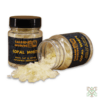-
×
 Sacred Plants - Maeng Da Kratom 75 mg/ml - Made of Kratom (Mitragyna speciosa) leaves from Indonesia, 5 ml 1 ×
Sacred Plants - Maeng Da Kratom 75 mg/ml - Made of Kratom (Mitragyna speciosa) leaves from Indonesia, 5 ml 1 ×€ 28,00€ 14,00You're getting this discount: 50% off
Subtotaal: € 14,00
 Sacred Plants - Maeng Da Kratom 75 mg/ml - Made of Kratom (Mitragyna speciosa) leaves from Indonesia, 5 ml
Sacred Plants - Maeng Da Kratom 75 mg/ml - Made of Kratom (Mitragyna speciosa) leaves from Indonesia, 5 ml Subtotaal: € 14,00
Botanical name: Bursera jorullense
Common name: Copal White
Plant part: Resin
Country: Mexico
Weight: 35 grams
Nicht vorrätig
Copal White or Copal Blanco. This white form of Copal has a light, bright, fruity scent. The fragrance of Copal is calming, grounding, and helpful in stress-related conditions.
White Copal is a superior form of Copal from Mexico. It is the resin from the Bursera jorullense tree of the Burseraceae family. It is different from the Protium copal tree from which the golden copal is harvested. White Copal is a higher quality than normal Copal and has a sweater scent.
The white form of Copal has a light, bright, fruity scent. It cleanses the spirit and can help with spiritual work. It clears the mind and traditional communities use it to improve mental health. When harvesting White Copal is a liquid which then dries and turns hard.
The word Copal comes from the indigenous Nahuatl language of the Aztecs which uses “copalli” to describe scented smoke. Nowadays it is a term people use to reference a wide variety if incense resins both fresh and semi fossilized.
The Aztecs would burn their copal in ceremonies to ward off spirits and clear negative energies. The Aztecs believed it promotes physical and mental health because it clears energetic blockages in the subtle bodies. Burning Copal helps aligning the chakras and as such harmonizes your inner self. Burning it releases a joyful smell that lifts the spirits and brings you in a to a meditative state of mind. The indigenous peoples of Mexico still use their Copal religiously when saying their prayers and performing their healing ceremonies.
Copal is a type of resin produced by plant or tree secretions, particularly identified with the forms of aromatic tree resins used by the cultures of pre-Columbian Mesoamerica as a ceremonially burned incense, as well as for a number of other purposes. The word Copal is derived from the Nahuatl language word “Copalli”, meaning “incense”. To the pre-Columbian Maya and contemporary Maya peoples it is known in the various Mayan languages as “Pom”, although the word itself has been demonstrated to be a loanword to Mayan from Mixe-Zoquean languages. It is sometimes likened to, or substituted for Amber and put in jewellery. Copal is still used by a number of indigenous peoples of Mexico and Central America as an incense, and during ceremonies such as the sweat lodge ceremony.
Copal resin has been used topically by healers in the Amazon. The incense was regarded as a seeing instrument for the Mayans and considered a form of protection against sorcery, illness, and misfortune. The incense still burns in many Mexican churches today for the purpose of making the body ritually clean. Copal resin is known to European medicine since 1625. Jesuits brought it back from the New World and it was called “Jesuit’s Balsam” where it was used medicinally. [1][2]
Bursera is a genus with about 100 described species of flowering shrubs and trees varying in size up to 25 m (82 ft) high. It is the type genus for Burseraceae. The trees are native (often for many species endemic) to the Americas, from the southern United States south through to northern Agentina, in tropical and warm temperate forest habitats.
Alloaromadendrene, alpha-bergamotene, alpha-cubebene, alpha-multijugenol, alpha-selinene, ar-curcumene, beta-bisabolene, beta-cubebene, beta-elemene, beta-farnesene, beta-humulene, beta-muurolene, beta-selinene, calamenene, calamesene, carioazulene, caryophyllenes, coipaiferic acid, copaene, copaiferolic acid, copalic acid, copaibic acids, cyperene, delta-cadinene, delta-elemene, enantio-agathic acid, gamma-cadinene, gamma-elemene, gamma-humulene, hardwickic acids, illurinic acid, kaurenoic acids, kaurenic acid, kolavenol 1, maracaibobalsam, methlyl copalate, paracopaibic acids, polyalthic acid, and trans-alpha-bergamotene.
Sweet, creamy-balsamic, spicy, slightly peppery. The fragrance of Copal calms anxiety, is grounding, and helpful in stress-related conditions. Useful in mental and spiritual work, helps open the deeper levels of the soul, stimulates imagination, intuition and creativity.
Copal blends well with Palo Santo (Bursera graveolens), Pine (Pinus edulis), Juniper (Juniperus communis), White Sage (Salvia apiana).
Only logged in customers who have purchased this product may leave a review.

Nicht vorrätig
Reviews
There are no reviews yet.